High Impact Tutoring Built By Math Experts
Personalized standards-aligned one-on-one math tutoring for schools and districts
In order to access this I need to be confident with:
Types of angles Supplementary angles Adjacent angles Perpendicular lines Polygons Intersecting linesParallel angles
Here you will learn how to recognize angles, use angle facts to find missing angles, and apply parallel angle facts to solve algebraic problems.
Students will first learn about parallel angles as a part of geometry in grade 8 and will expand on their learning throughout high school.
What are parallel angles?
Parallel angles are angles that are created when a pair of parallel lines are intersected by a third line called a transversal.
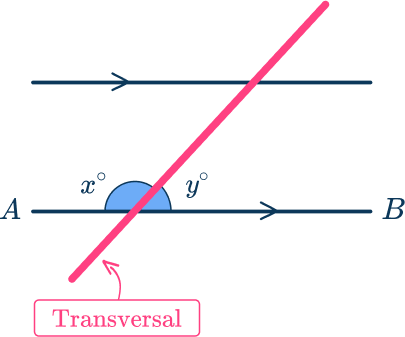
You can use the information given in the diagram to find any angle around the intersecting transversal.
To do this, use three facts about angles in parallel lines: Alternate Angles, Co-Interior Angles, and Corresponding Angles.
![[FREE] Angles Check for Understanding Quiz (Grade 4)](https://thirdspacelearning.com/wp-content/uploads/2023/08/Angles-check-for-understanding-quiz-listing-image.png)
[FREE] Angles Check for Understanding Quiz (Grade 4)
![[FREE] Angles Check for Understanding Quiz (Grade 4)](https://thirdspacelearning.com/wp-content/uploads/2023/08/Angles-check-for-understanding-quiz-listing-image.png)
Use this quiz to check your grade 4 students’ understanding of angles. 10+ questions with answers covering a range of 4th grade angles topics to identify areas of strength and support!
DOWNLOAD FREE![[FREE] Angles Check for Understanding Quiz (Grade 4)](https://thirdspacelearning.com/wp-content/uploads/2023/08/Angles-check-for-understanding-quiz-listing-image.png)
[FREE] Angles Check for Understanding Quiz (Grade 4)
![[FREE] Angles Check for Understanding Quiz (Grade 4)](https://thirdspacelearning.com/wp-content/uploads/2023/08/Angles-check-for-understanding-quiz-listing-image.png)
Use this quiz to check your grade 4 students’ understanding of angles. 10+ questions with answers covering a range of 4th grade angles topics to identify areas of strength and support!
DOWNLOAD FREEProperties of parallel lines
- Alternate interior angles are equal
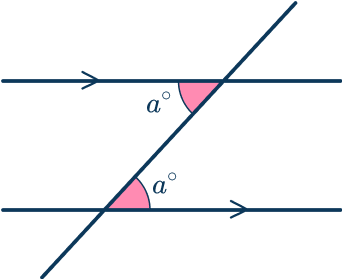
Sometimes called ‘Z angles’
- Corresponding angles are equal
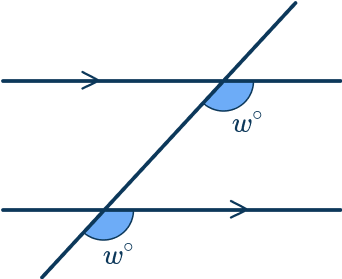
Sometimes called ‘F angles’
- Co-interior angles add up to \bf{180}^{\circ}
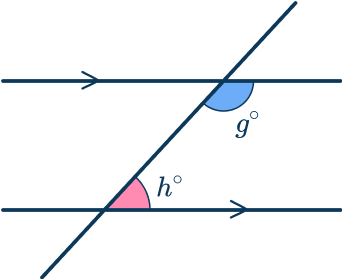
Sometimes called ‘C angles’
Key angle facts
To explore parallel angles, you will need to use some key angle facts.
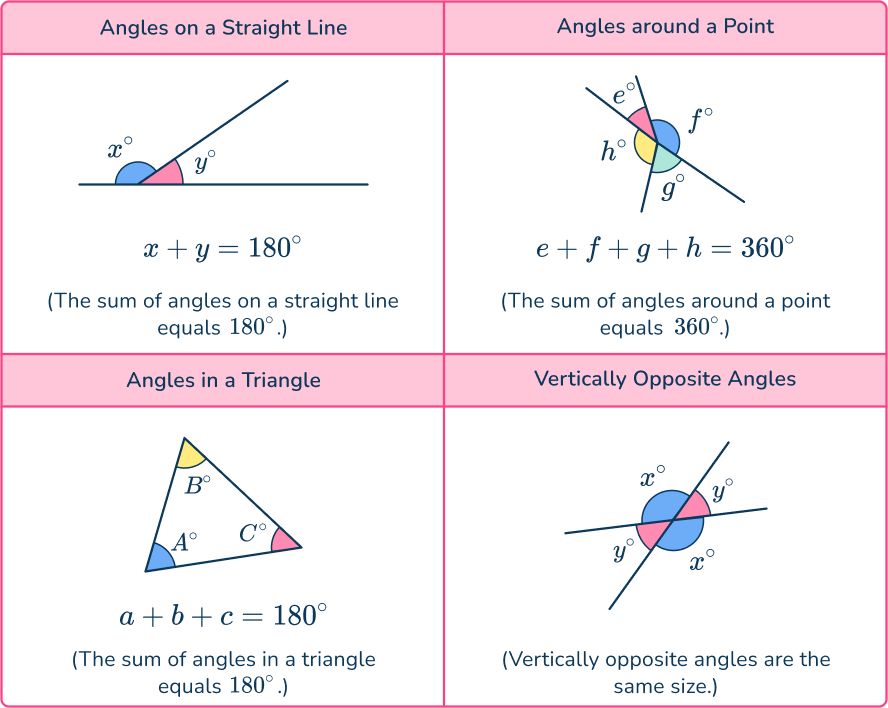
Parallel angles
It is known that vertically opposite angles are equal and can be shown around a point within parallel lines:
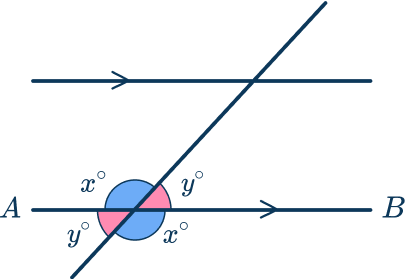
If the transversal line is extended so that it crosses more parallel lines, the angles are maintained throughout the diagram for any line parallel to the original line AB.
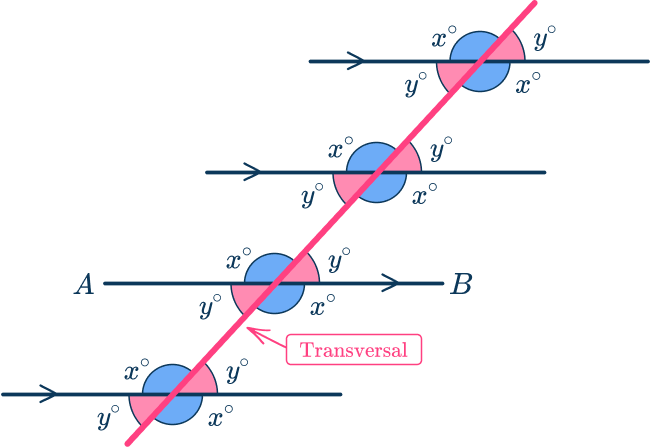
NOTE: For the same intersecting transversal, all the acute angles are the same size, and all the obtuse angles are the same size.
You can group these angles into three separate types called alternate angles, same side interior angles and corresponding angles.
Alternate angles
Alternate angles are angles that occur on opposite sides of the transversal line and have the same size.
Each pair of alternate angles around the transversal are equal to each other. The two angles can either be a pair of alternate interior angles or alternate exterior angles.
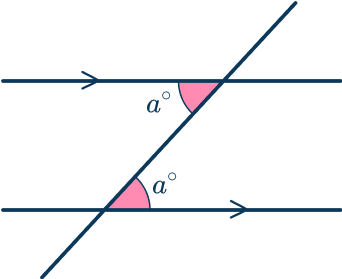
Other examples of alternate angles:

You can often spot interior alternate angles by drawing a Z shape.
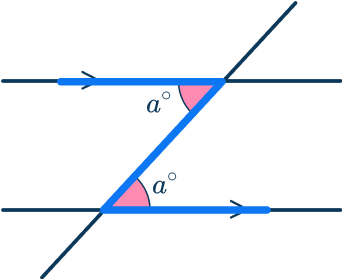
Step by step: Alternate interior angles theorem
Corresponding angles
The pairs of angles formed on the same side of the transversal that are either both obtuse or both acute are called corresponding angles and are equal in size.
Each pair of corresponding angles on the same side of the intersecting transversal is equal to each other.
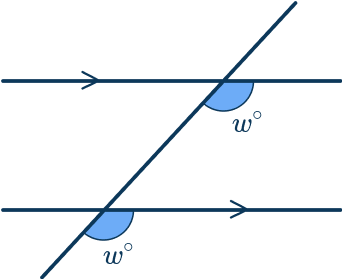
Other examples of corresponding angles:

You can often spot interior corresponding angles by drawing an F shape.
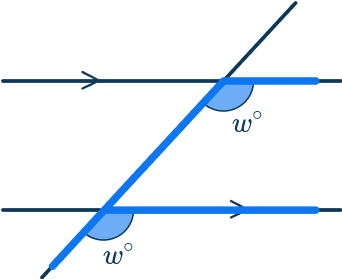
Step by step: Corresponding angles
Same side interior angles (co-interior angles)
Same side interior angles, or consecutive interior angles occur in between two parallel lines when they are intersected by a transversal. The two angles that occur on the same side of the transversal always add up to 180^{\circ} .
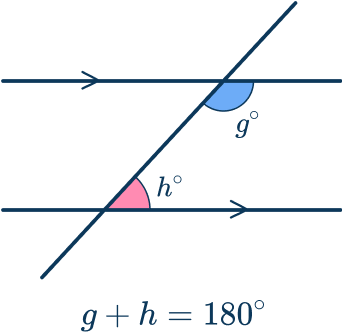
Other examples of same side interior angles:

You can often spot same side interior angles by drawing a C shape.
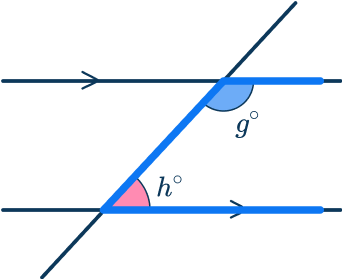
Step by step: Same side interior angles
You may need to apply one or multiple different angle rules to work out missing angles in parallel lines.
It is important to note that most problems do not have a unique method to obtain a solution so it is crucial to be very clear with your working out.
What are parallel angles?
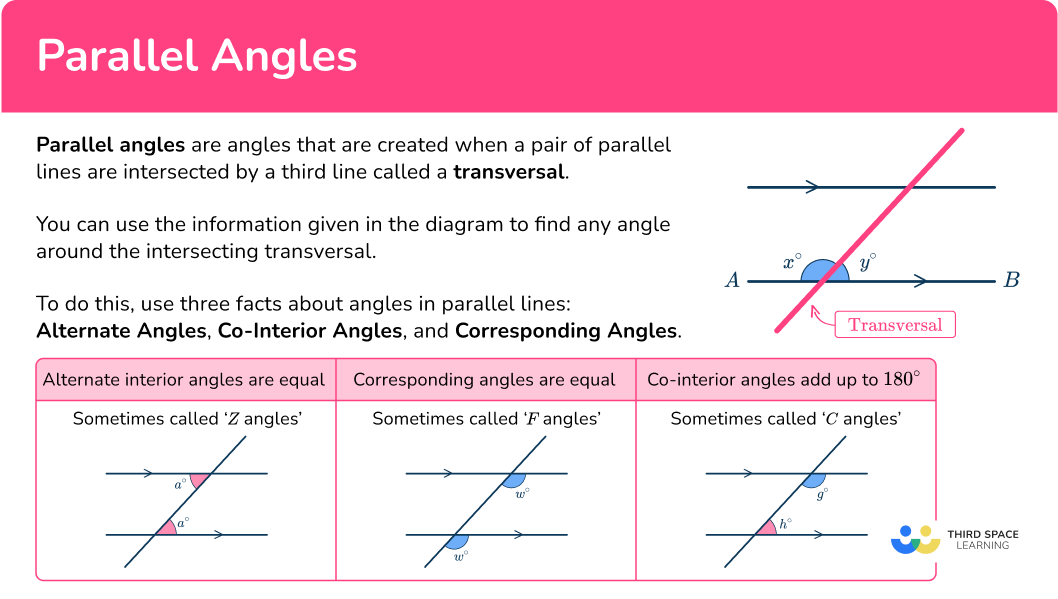
Common Core State Standards
How does this relate to 8 th grade math and high school math?
- Grade 8: Geometry (8.G.A.5)
Use informal arguments to establish facts about the angle sum and exterior angle of triangles, about the angles created when parallel lines are cut by a transversal, and the angle-angle criterion for similarity of triangles.
For example, arrange three copies of the same triangle so that the sum of the three angles appears to form a line, and give an argument in terms of transversals why this is so.
- High School: Geometry (HS.G.CO.C.9)
Prove theorems about lines and angles.
Theorems include: vertical angles are congruent; when a transversal crosses parallel lines, alternate interior angles are congruent and corresponding angles are congruent; points on a perpendicular bisector of a line segment are exactly those equidistant from the segment’s endpoints.
How to find a missing angle in parallel lines
In order to find a missing angle in parallel lines:
- Highlight the angle(s) that you already know.
- State the alternate angle, co-interior angle or corresponding angle fact to find a missing angle in the diagram.
- Use basic angle facts to calculate the missing angle.
NOTE: Steps 2 and 3 may be done in either order and may need to be repeated. Step 3 may not always be required.
Parallel angles examples
For each stage of the calculation, you must clearly state any angle facts that are used.
Example 1: alternate angles
Calculate the size of the missing angle \theta. Justify your answer.
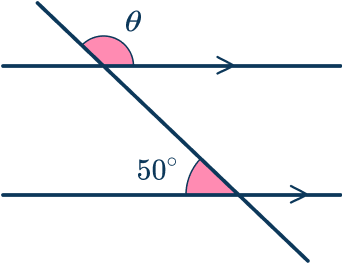
- Highlight the angle(s) that you already know.
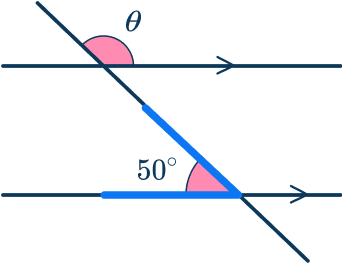
2State the alternate angle, co-interior angle or corresponding angle fact to find a missing angle in the diagram.
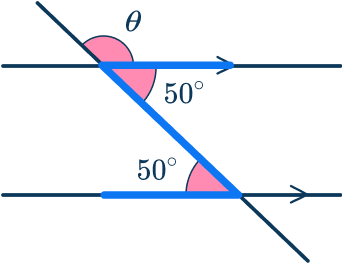
Here you can label the alternate angle on the diagram as 50^{\circ} .
3Use a basic angle fact to calculate the missing angle.
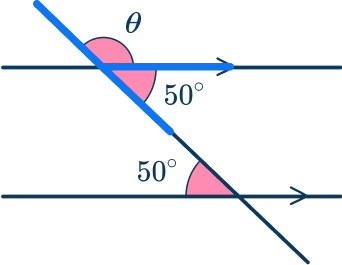
Here as \theta is on a straight line with 50^{\circ},
\begin{aligned}\theta &= 180-50 \\\\ \theta &= 130^{\circ} \end{aligned}Example 2: same side interior angles
Calculate the size of the missing angle \theta. Justify your answer.
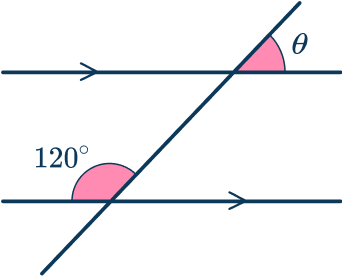
Highlight the angle(s) that you already know.
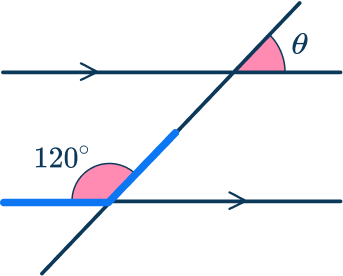
State the alternate angle, co-interior angle or corresponding angle fact to find a missing angle in the diagram.
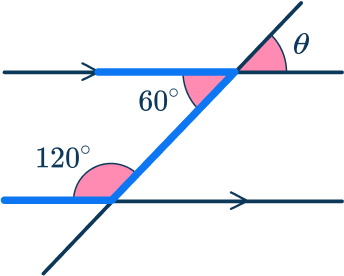
Here you can label the co-interior angle on the diagram as 60^{\circ} as 180-120=60^{\circ}.
Use a basic angle fact to calculate the missing angle.
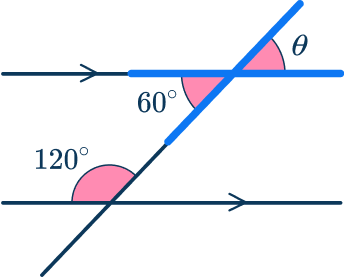
You can see that as \theta is vertically opposite to 60^{\circ}, therefore \theta=60^{\circ}.
Example 3: corresponding angles
Calculate the size of the missing angle \theta. Justify your answer.
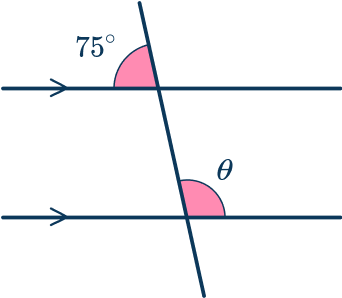
Highlight the angle(s) that you already know.
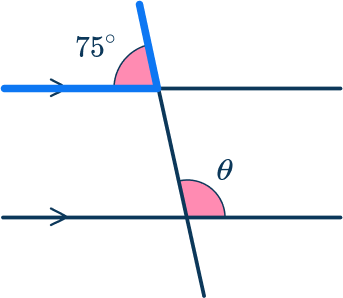
State the alternate angle, co-interior angle or corresponding angle fact to find a missing angle in the diagram.
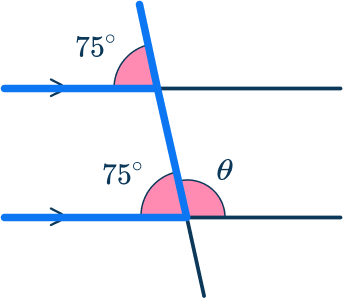
Here you can label the corresponding angle on the diagram as 75^{\circ}.
Use a basic angle fact to calculate the missing angle.
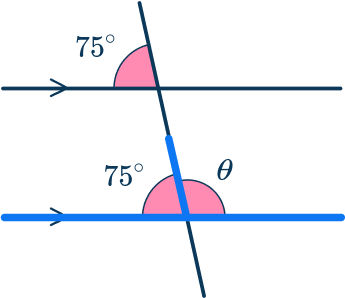
Here as \theta is on a straight line with 75^{\circ},
Example 4: multi-step
Calculate the missing angle \theta. Show all your work.
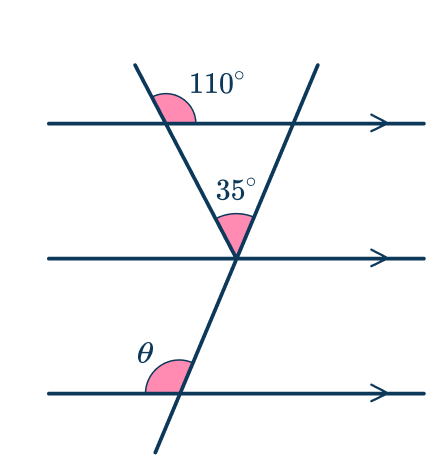
Highlight the angle(s) that you already know.
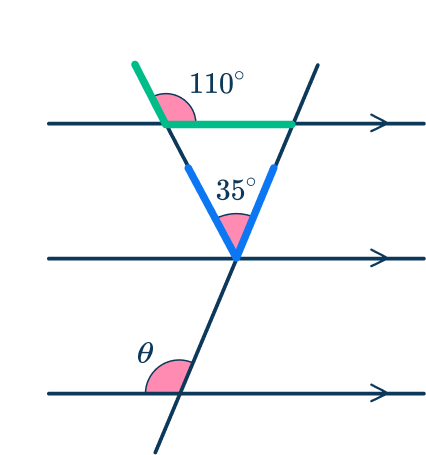
Use a basic angle fact to calculate a missing angle.
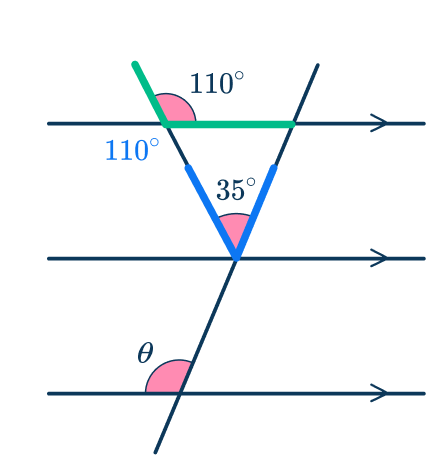
Opposite angles are equal so you can label the angle 110^{\circ}.
State the alternate angle, co-interior angle or corresponding angle fact to find a missing angle in the diagram.
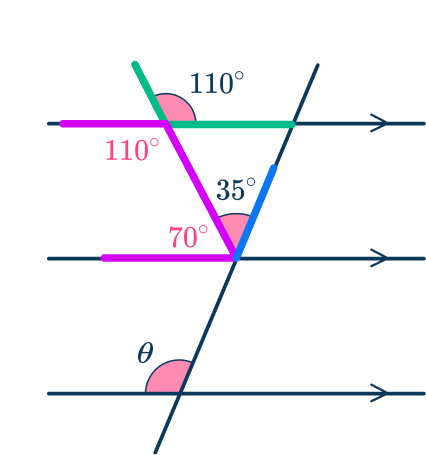
Co-interior angles add up to 180^{\circ}. Here 180-110=70^{\circ}.
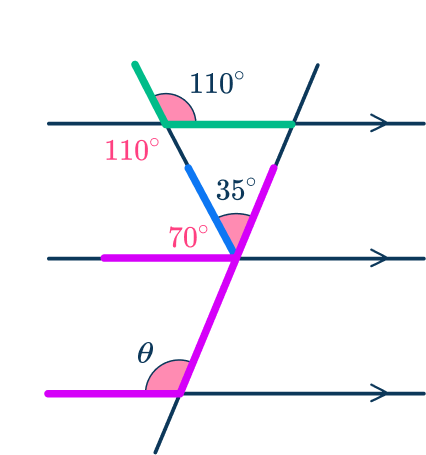
\theta is corresponding to 70+35 so \theta=70+35=105^{\circ}.
Example 5: similar triangles
Show that the two triangles are similar.
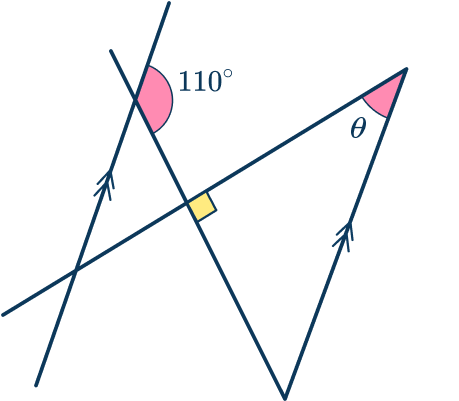
Highlight the angle(s) that you already know.
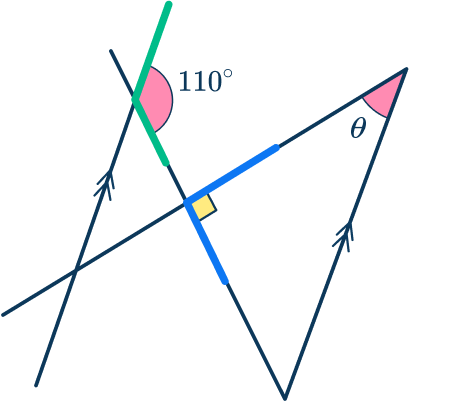
Use a basic angle fact to calculate a missing angle.
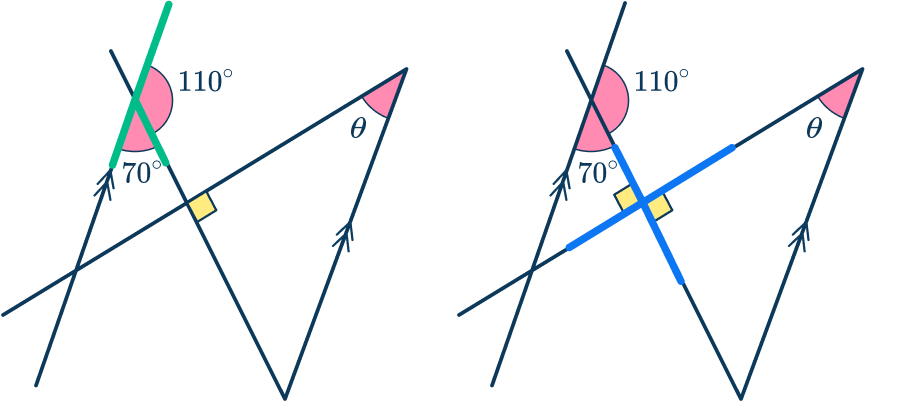
Here, you can see that the two angles highlighted in green are on a straight line and so their sum is 180^{\circ}. This gives us the missing angle of 70^{\circ}.
You can also see there are vertically opposite angles at the center of the diagram, both are 90^{\circ}.
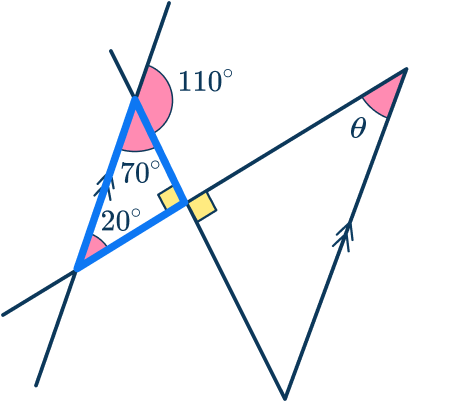
The smaller triangle now has a missing angle of 20^{\circ} as angles in a triangle add to equal 180^{\circ}.
State the alternate angle, co-interior angle or corresponding angle fact to find a missing angle in the diagram.
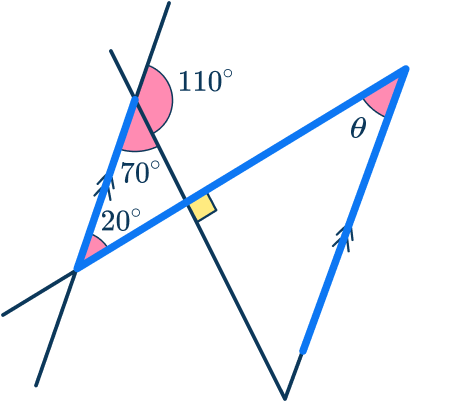
By stating the alternate angles to 70^{\circ} and 20^{\circ} you can see that \theta=20^{\circ} and the other angle in the triangle is 70^{\circ}. The two triangles contain the same angles and are therefore similar.
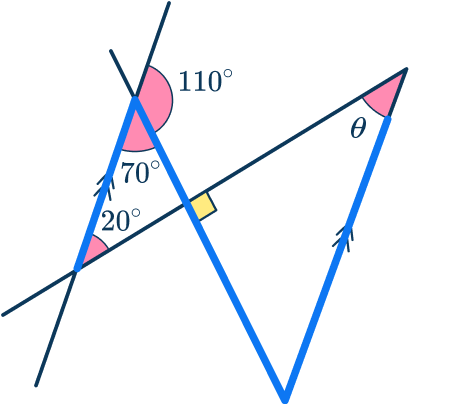
Example 6: angles in parallel lines including algebra
Given that the sum of angles on a straight line is equal to 180^{\circ}, calculate the value of x. Calculate the size of angle 4x+30.
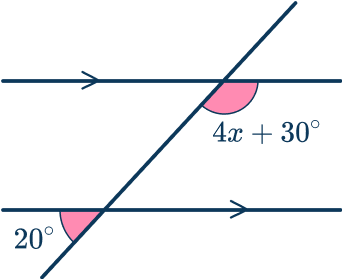
Highlight the angle(s) that you already know.
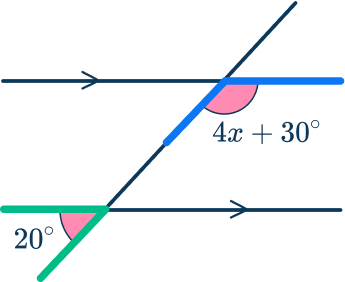
State the alternate angle, co-interior angle or corresponding angle fact to find a missing angle in the diagram.
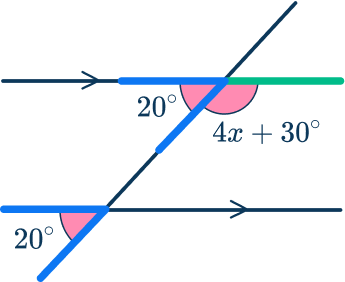
State that 20^{\circ} is corresponding to the original angle.
Use a basic angle fact to calculate the missing angle.
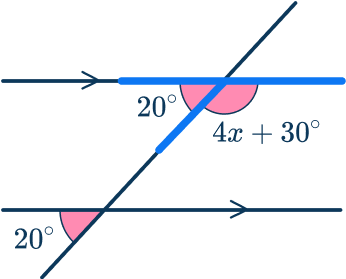
As the sum of angles on a straight line is 180^{\circ}, you have
Now that x=32.5^{\circ},
Teaching tips for parallel angles
- Students should be familiar with the basic concepts before attempting to work with parallel angles. Make sure students understand lines, rays, and the different types of angles.
- If using worksheets to provide practice to students, make sure to provide different levels of complexity to challenge students.
Easy mistakes to make
- Mixing up angle facts
There are a lot of angle facts and it is easy to mistake alternate angles with corresponding angles. To prevent this from occurring, think about the alternate angles being on the alternate sides of the line.
- Using a protractor to measure an angle
Most diagrams are not to scale so using a protractor will not result in a correct answer unless it is a coincidence.
Practice parallel angle problems
1. Calculate the size of angle \theta.
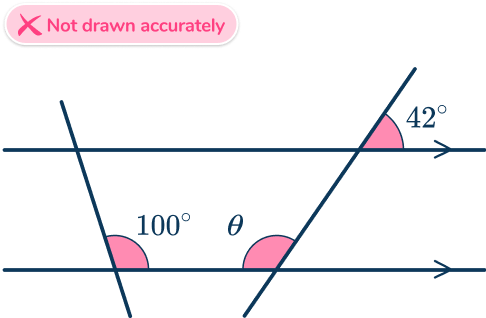




Using corresponding angles, the angle measures 42^{\circ}.
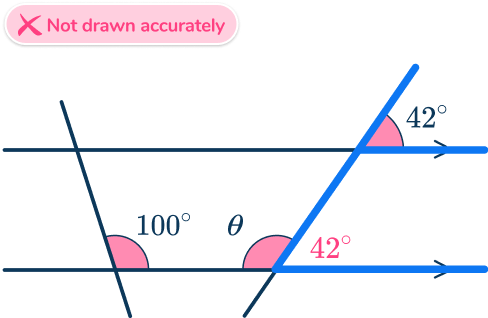
Then use angles on a straight line:
\theta=180-42= 138^{\circ}
2. Calculate the size of angle \theta.
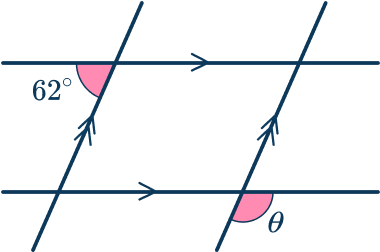




Using co-interior angles, calculate 180-62=118^{\circ}.
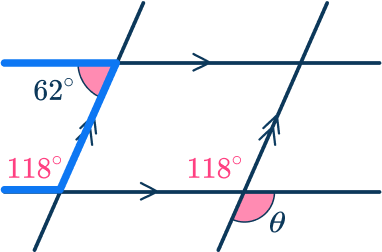
Label the corresponding angle 118^{\circ}.
Since opposite angles are equal,
\theta=118^{\circ}
3. Calculate the angle \theta.
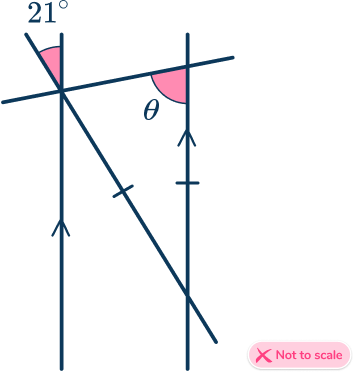




Using opposite angles, the angle measures 21^{\circ}.
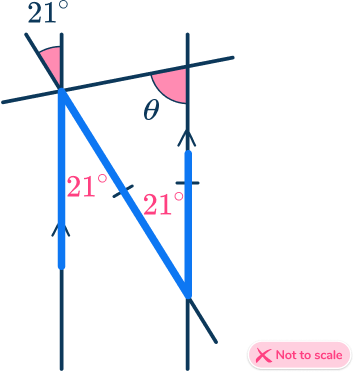
Next, label the alternate angle 21^{\circ}.
Then, use the fact that it is an isosceles triangle and so two angles are equal:
\theta=\cfrac{180-21}{2}=79.5^{\circ}.
4. Calculate the size of angle \theta.
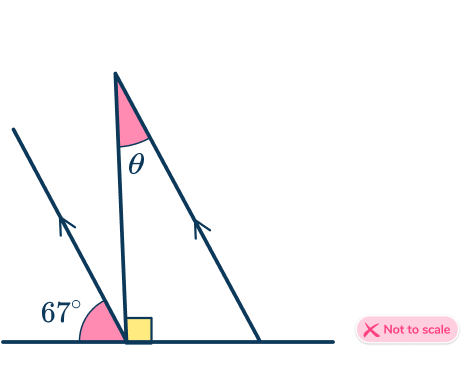




Using angles on a straight line, calculate 180-(90+67)=23^{\circ}.
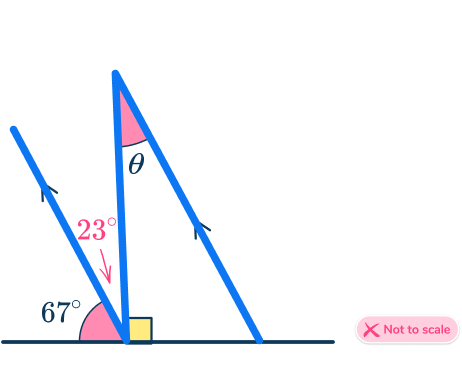
Use alternate angles to find \theta=23^{\circ}.
5. Calculate the size of angle \theta.
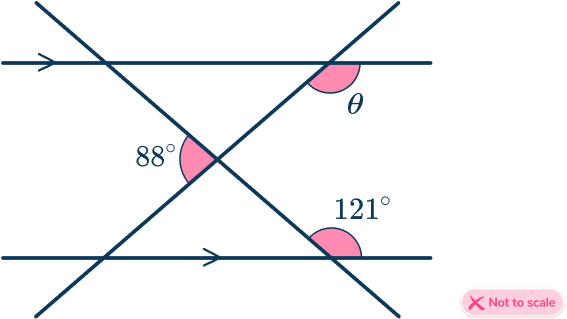




Using angles on a straight line, calculate the angles 92^{\circ} and 59^{\circ}.
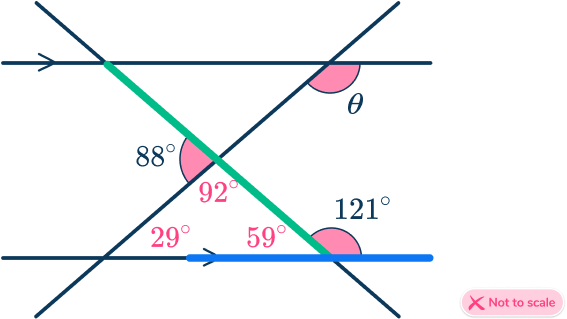
Then the other angle in the triangle is 180-(92+59)=29^{\circ}.
Using angles on a straight line, calculate 180-29=151^{\circ}.
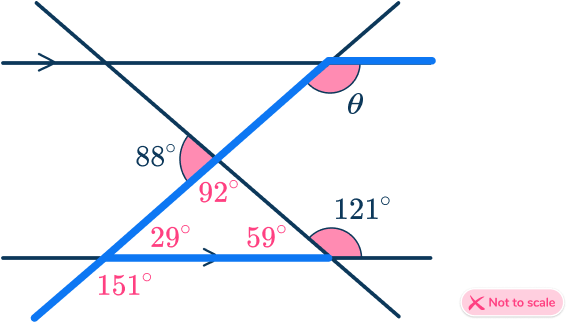
Finally, using corresponding angles, \theta=151^{\circ}
6. By calculating the value of x, find the value of \theta.
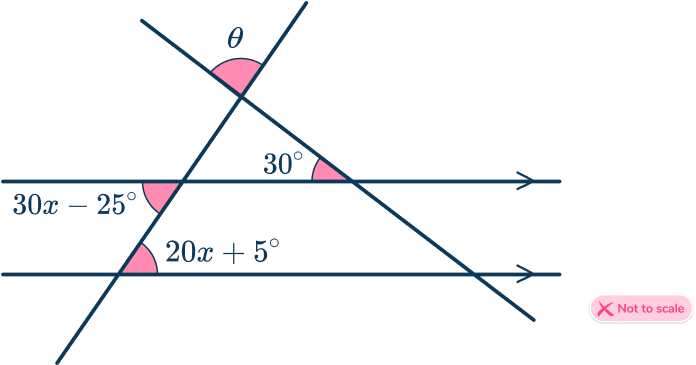




30x-25 and 20x+5 are alternate angles, therefore, you can write 30x-25=20x+5
Then solve to find x\text{:}
\begin{aligned}30x-25&=20x+5 \\\\ 10x-25&=5 \\\\ 10x&=30 \\\\ x&=3 \end{aligned}
Given that x=3,
30 \times 3-25=65
Using opposite angles, notice that the angle inside the triangle is 65^{\circ}.
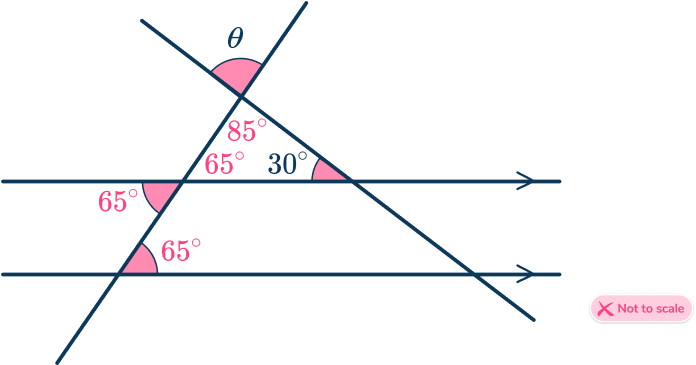
Using angles in a triangle, calculate the third angle in the triangle: 180-(65+30)=85^{\circ}.
Then using opposite angles, \theta=85^{\circ}.
Parallel angles FAQs
Parallel angles are the types of angles that are formed when two parallel lines are cut by a transversal line. These types of angles include corresponding angles, alternate interior angles, alternate exterior angles and same side interior angles.
Parallel lines are two lines that will never intersect and are always an equal distance apart from each other. A transversal line is a line that crosses at least two other lines.
When a transversal line crosses parallel lines, several types of angles are created, including corresponding angles, alternate interior angles, and alternate exterior angles.
The next lessons are
Still stuck?
At Third Space Learning, we specialize in helping teachers and school leaders to provide personalized math support for more of their students through high-quality, online one-on-one math tutoring delivered by subject experts.
Each week, our tutors support thousands of students who are at risk of not meeting their grade-level expectations, and help accelerate their progress and boost their confidence.

Find out how we can help your students achieve success with our math tutoring programs.
[FREE] Common Core Practice Tests (3rd to 8th Grade)
Prepare for math tests in your state with these 3rd Grade to 8th Grade practice assessments for Common Core and state equivalents.
Get your 6 multiple choice practice tests with detailed answers to support test prep, created by US math teachers for US math teachers!